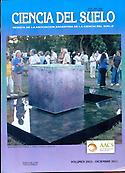Ver ítem
- xmlui.general.dspace_homeCentros Regionales y EEAsCentro Regional La Pampa - San LuisEEA AnguilArtículos científicosxmlui.ArtifactBrowser.ItemViewer.trail
- Inicio
- Centros Regionales y EEAs
- Centro Regional La Pampa - San Luis
- EEA Anguil
- Artículos científicos
- Ver ítem
Raíces de cultivos de cobertura. Cantidad, distribución e influencia sobre el n mineral = Cover crop roots: quantity, distribution and influence on soil mineral n
Resumen
Los objetivos fueron: i) evaluar la cantidad y distribución de raíces de centeno y vicia como cultivos de cobertura (CC) y; ii) cuantificar el aporte de N de raíces en el perfil y su impacto sobre la disponibilidad de N-nitratos en el suelo. La experiencia se desarrolló en dos suelos: Paleustol petrocálcico y Ustipsamment típico y en ensayos de larga duración con rotaciones que incluyen CC y sorgo o maíz para silo. Los tratamientos fueron un testigo sin
[ver mas...]
Los objetivos fueron: i) evaluar la cantidad y distribución de raíces de centeno y vicia como cultivos de cobertura (CC) y; ii) cuantificar el aporte de N de raíces en el perfil y su impacto sobre la disponibilidad de N-nitratos en el suelo. La experiencia se desarrolló en dos suelos: Paleustol petrocálcico y Ustipsamment típico y en ensayos de larga duración con rotaciones que incluyen CC y sorgo o maíz para silo. Los tratamientos fueron un testigo sin CC (T), centeno (C), centeno fertilizado con 60 kg N ha-1 (C+N), vicia (V) y la consociación vicia-centeno (VC) dispuestos en un diseño en bloques completamente aleatorizados con cuatro réplicas. Al secado de los CC de la campaña 2015 se determinó cantidad, calidad y distribución de raíces hasta el metro de profundidad estratificando cada 20 cm (BRT), biomasa aérea (BA) y N-nitratos en suelo. En el Ustipsamment la biomasa de raíces hasta el metro de vicia (3165 kg ha 1) resultó inferior al centeno solo o con N (4459 kg ha-1). En este suelo la gramínea presentó mayor acumulación de raíces en los primeros 20 cm del perfil (88%) respecto de la leguminosa (62%). En cambio, en el Paleustol no se observaron diferencias entre V y C o C+N, que en promedio produjeron 4195 kg ha-1 de raíces al metro, aunque inferiores a VC (5014 kg ha-1). La acumulación en el horizonte superficial en este suelo fue similar entre especies (57%).
En general, la relación BRT/BA en V fue superior a C (0,98 y 0,49, respectivamente). El aporte de N-raíces varió entre 50 y 75 kg ha-1 y se encontró una relación lineal y positiva entre esta variable y el N mineral a partir de los 15-30 días de secados los CC a 0-20 cm, y a partir de los 45-65 días, para el estrato de 20-100 cm dependiendo del tipo de suelo.
[Cerrar]
The objectives of the work were: i) Evaluate the amount and distribution of rye and vetch roots as cover crops (CC); ii) Quantify
the contribution of N-roots in the profile and their impact on N-nitrate availability in the soil. The study was carried out
in two soils: Petrocalcic Paleustoll and Typic Ustipsamment in long duration trials with rotations including CC and sorghum
or maize for silage. Treatments were a control without CC (T), rye (C), rye
[ver mas...]
The objectives of the work were: i) Evaluate the amount and distribution of rye and vetch roots as cover crops (CC); ii) Quantify
the contribution of N-roots in the profile and their impact on N-nitrate availability in the soil. The study was carried out
in two soils: Petrocalcic Paleustoll and Typic Ustipsamment in long duration trials with rotations including CC and sorghum
or maize for silage. Treatments were a control without CC (T), rye (C), rye fertilized with 60N (C+N), vetch (V), and vetchrye
consociation (VC) arranged in a completely randomized block design with four replicates. At the end of CC growing season
in 2015 root quantity, quality and distribution up to 1 m depth stratified every 0,20 m (BRT), aerial biomass (BA) and Nnitrates
in soil were determined. In the Ustipsamment vetch root biomass at 1 m depth (3165 kg ha-1) was lower than rye
alone or with N (4459 kg ha-1). In this soil, the grass showed higher root biomass accumulation in the first 20 cm (88%)
than the legume (62%). In contrast, in the Paleustoll no differences were found between V and C or C+N, which produced
on average 4195 kg ha-1 of roots at 1 m depth, value that was lower than the corresponding to VC (5014 kg ha-1). In this
soil, BRT in the uppermost soil layer was similar between species (57%). In general, BRT/BA ratio in V was higher than C
(0.98 and 0.49). N-root contribution varied between 50 and 75 kg ha-1. A linear and positive relationship was found between
N-root and mineral N starting from 15-30 days from the end of CC at 0-20 cm depth and from 45-65 days for the 20-
100 cm stratum depending on soil type.
[Cerrar]

Autor
Oderiz, Juan Agustin;
Uhaldegaray, Mauricio Gaston;
Frasier, Ileana;
Quiroga, Alberto Raul;
Amiotti, Nilda Mabel;
Zalba, Pablo;
Fuente
Ciencia del suelo 35 (2) : 249-258. (2017)
Fecha
2017
Editorial
Asociación Argentina de la Ciencia del Suelo
ISSN
0326-3169
Formato
pdf
Tipo de documento
artículo
Palabras Claves
Derechos de acceso
Abierto
 Excepto donde se diga explicitamente, este item se publica bajo la siguiente descripción: Creative Commons Attribution-NonCommercial-ShareAlike 2.5 Unported (CC BY-NC-SA 2.5)
Excepto donde se diga explicitamente, este item se publica bajo la siguiente descripción: Creative Commons Attribution-NonCommercial-ShareAlike 2.5 Unported (CC BY-NC-SA 2.5)


